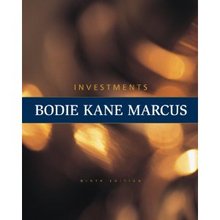This is completed downloadable of Investments Bodie Kane Marcus 9th Edition Test Bank

Product Details:
- ISBN-10 : 0073530700
- ISBN-13 : 978-0073530703
- Author:
Bodie, Kane, and Marcus’ Investments sets the standard for graduate/MBA investments textbooks. It blends practical and theoretical coverage, while maintaining an appropriate rigor and a clear writing style. Its unifying theme is that security markets are nearly efficient, meaning that most securities are priced appropriately given their risk and return attributes. The text places greater emphasis on asset allocation and offers a much broader and deeper treatment of futures, options, and other derivative security markets than most investment texts. It is also the only graduate Investments text to offer an online homework management system, McGraw-Hill’s Connect Finance.
Table of Content:
- PART I: INTRODUCTION
- CHAPTER 1 The Investment Environment
- 1.1 Real Assets versus Financial Assets
- 1.2 Financial Assets
- 1.3 Financial Markets and the Economy
- The Informational Role of Financial Markets
- Consumption Timing
- Allocation of Risk
- Separation of Ownership and Management
- Corporate Governance and Corporate Ethics
- 1.4 The Investment Process
- 1.5 Markets Are Competitive
- The Risk–Return Trade-Off
- Efficient Markets
- 1.6 The Players
- Financial Intermediaries
- Investment Bankers
- Venture Capital and Private Equity
- 1.7 The Financial Crisis of 2008
- Antecedents of the Crisis
- Changes in Housing Finance
- Mortgage Derivatives
- Credit Default Swaps
- The Rise of Systemic Risk
- The Shoe Drops
- The Dodd–Frank Reform Act
- The Canadian Experience of the Financial Crisis
- 1.8 Outline of the Text
- End of Chapter Material
- CHAPTER 2 Financial Markets, Asset Classes, and Financial Instruments
- 2.1 The Money Market
- Treasury Bills
- Certificates of Deposit
- Commercial Paper
- Bankers’ Acceptances
- Repos and Reverses
- The Bank of Canada Overnight Rate and the U.S. Federal Funds Rate
- Brokers’ Call Loans
- The LIBOR Market
- Yields on Money Market Instruments
- T-Bill Yields
- 2.2 The Bond Market
- Government of Canada Bonds
- Inflation-Protected Bonds
- Provincial Bonds
- Corporate Bonds
- Municipal Bonds
- International Bonds
- Mortgages and Mortgage-Backed Securities
- 2.3 Equity Securities
- Common Stock as Ownership Shares
- Characteristics of Common Stock
- Stock Market Listings
- Income Trusts
- Preferred Stock
- Depository Receipts
- 2.4 Stock and Bond Market Indexes
- Stock Market Indexes
- Toronto Stock Exchange Indexes
- Dow Jones Averages
- Standard & Poor’s U.S. Indexes
- Other U.S. Market-Value Indexes
- Equally Weighted Indexes
- Other Foreign and International Stock Market Indexes
- Bond Market Indicators
- 2.5 Derivative Markets
- Options
- Futures Contracts
- Other Derivative Assets Warrants, Swaps, and Hybrid Securities
- End of Chapter Material
- CHAPTER 3 How Securities Are Traded
- 3.1 How Firms Issue Securities
- Privately Held Firms
- Publicly Traded Companies
- Shelf Registration
- Short Form Prospectus Distribution System (SFPD)
- Initial Public Offerings
- 3.2 How Securities Are Traded
- Types of Markets and Orders
- Types of Orders
- Trading Mechanisms
- The Execution of Trades
- Settlement
- The Rise of Electronic Trading
- 3.3 Securities Markets
- The Toronto Stock Exchange
- The Bond Market
- U.S. Markets
- NASDAQ
- The New York Stock Exchange
- ECNs
- New Trading Strategies
- Foreign Markets
- Derivative Markets
- 3.4 Trading Costs
- Internet Investing
- 3.5 Trading with Margin and Short Sales
- Trading with Margin
- Buying on Margin
- Short Sales
- 3.6 Regulation of Securities Markets
- Regulatory Responses to Recent Scandals and the 2008–09 Financial Crisis
- Self-Regulation and Circuit Breakers
- Short-Selling Circuit Breakers
- Insider Trading
- End of Chapter Material
- Appendix 3A A Detailed Margin Position
- CHAPTER 4 Mutual Funds and Other Investment Companies
- 4.1 Investment Companies
- 4.2 Types of Investment Companies
- Other Investment Organizations
- 4.3 Mutual Funds
- Investment Policies
- How Funds Are Sold
- 4.4 Costs of Investing in Mutual Funds
- Fee Structure
- Fees and Mutual Fund Returns
- 4.5 Taxation of Mutual Fund Income
- 4.6 Exchange-Traded Funds
- 4.7 Mutual Fund Investment Performance A First Look
- 4.8 Information on Mutual Funds
- End of Chapter Material
- PART II: PORTFOLIO THEORY AND PRACTICE
- CHAPTER 5 Risk, Return, and the Historical Record
- 5.1 Determinants of the Level of Interest Rates
- Real and Nominal Rates of Interest
- The Equilibrium Real Rate of Interest
- The Equilibrium Nominal Rate of Interest
- Taxes and the Real Rate of Interest
- 5.2 Comparing Rates of Return for Different Holding Periods
- Annual Percentage Rates
- Continuous Compounding
- 5.3 Bills and Inflation, 1957–2016
- 5.4 Risk and Risk Premiums
- Holding-Period Returns
- Expected Return and Standard Deviation
- Excess Returns and Risk Premiums
- 5.5 Time Series Analysis of Past Rates of Return
- Time Series versus Scenario Analysis
- Expected Returns and the Arithmetic Average
- The Geometric (Time-Weighted) Average Return
- Variance and Standard Deviation
- Mean and Standard Deviation Estimates from Higher-Frequency Observations
- The Reward-to-Volatility (Sharpe) Ratio
- 5.6 The Normal Distribution
- 5.7 Deviations from Normality and Alternative Risk Measures
- Value at Risk
- Expected Shortfall
- Lower Partial Standard Deviation and the Sortino Ratio
- Relative Frequency of Large, Negative 3-Sigma Returns
- 5.8 Historic Returns on Risky Portfolio
- A Global View of the Historical Record
- 5.9 Long-Term Investments
- Short-Run versus Long-Run Risk
- Forecasts for the Long Haul
- End of Chapter Material
- CHAPTER 6 Capital Allocation to Risky Assets
- 6.1 Risk and Risk Aversion
- Risk, Speculation, and Gambling
- Risk Aversion and Utility Values
- Estimating Risk Aversion
- 6.2 Capital Allocation Across Risky and Risk-Free Portfolios
- 6.3 The Risk-Free Asset
- 6.4 Portfolios of One Risky Asset and a Risk-Free Asset
- 6.5 Risk Tolerance and Asset Allocation
- Non-normal Returns
- 6.6 Passive Strategies The Capital Market Line
- End of Chapter Material
- Appendix 6A Risk Aversion, Expected Utility, and the St. Petersburg Paradox
- Appendix 6B Utility Functions and Risk Premiums
- CHAPTER 7 Optimal Risky Portfolios
- 7.1 Diversification and Portfolio Risk
- 7.2 Portfolios of Two Risky Assets
- 7.3 Asset Allocation with Stocks, Bonds, and Bills
- Asset Allocation with Two Risky Asset Classes
- 7.4 The Markowitz Portfolio Optimization Model
- Security Selection
- Capital Allocation and the Separation Property
- The Power of Diversification
- Asset Allocation and Security Selection
- Optimal Portfolios and Non-normal Returns
- 7.5 Risk Pooling, Risk Sharing, and the Risk of Long-Term Investments
- Risk Pooling and the Insurance Principle
- Risk Sharing
- Diversification and the Sharpe Ratio
- Time Diversification and the Investment Horizon
- End of Chapter Material
- Appendix 7A A Spreadsheet Model for Efficient Diversification
- Appendix 7B Review of Portfolio Statistics
- CHAPTER 8 Index Models
- 8.1 A Single-Factor Security Market
- The Input List of the Markowitz Model
- Systematic versus Firm-Specific Risk
- 8.2 The Single-Index Model
- The Regression Equation of the Single-Index Model
- The Expected Return–Beta Relationship
- Risk and Covariance in the Single-Index Model
- The Set of Estimates Needed for the Single-Index Model
- The Index Model and Diversification
- 8.3 Estimating the Single-Index Model
- The Security Characteristic Line for Suncor
- The Explanatory Power of the SCL for Suncor
- The Estimate of Alpha
- The Estimate of Beta
- Firm-Specific Risk
- 8.4 The Industry Version of the Index Model
- Company Beta Estimates
- Predicting Betas
- Index Models and Tracking Portfolios
- Portfolio Construction Using the Single-Index Model with a Detailed Example
- Alpha and Security Analysis
- The Index Portfolio as an Investment Asset
- The Single-Index-Model Input List
- The Optimal Risky Portfolio in the Single-Index Model
- The Information Ratio
- Summary of Optimization Procedure
- An Example
- Correlation and Covariance Matrix
- Is the Index Model Inferior to the Full-Covariance Models?
- End of Chapter Material
- PART III: EQUILIBRIUM IN CAPITAL MARKETS
- CHAPTER 9 The Capital Asset Pricing Model
- 9.1 The Capital Asset Pricing Model
- Why Do All Investors Hold the Market Portfolio?
- The Passive Strategy Is Efficient
- The Risk Premium of the Market Portfolio
- Expected Returns on Individual Securities
- The Security Market Line
- The CAPM and the Single-Index Market
- 9.2 Assumptions and Extensions of the CAPM
- Identical Input Lists
- Risk-Free Borrowing and the Zero-Beta Model
- Labour Income and Non-traded Assets
- A Multi-period Model and Hedge Portfolios
- A Consumption-Based CAPM
- Liquidity and the CAPM
- 9.3 The CAPM and the Academic World
- 9.4 The CAPM and the Investment Industry
- End of Chapter Material
- CHAPTER 10 Arbitrage Pricing Theory and Multifactor Models of Risk and Return
- 10.1 Multifactor Models An Overview
- Factor Models of Security Returns
- 10.2 Arbitrage Pricing Theory
- Arbitrage, Risk Arbitrage, and Equilibrium
- Well-Diversified Portfolios
- Diversification and Residual Risk in Practice
- Executing Arbitrage
- The No-Arbitrage Equation of the APT
- 10.3 The APT, the CAPM, and the Index Model
- The APT and the CAPM
- The APT and Portfolio Optimization in a Single-Index Market
- 10.4 A Multifactor APT
- 10.5 The Fama–French (FF) Three-Factor Model
- End of Chapter Material
- CHAPTER 11 The Efficient Market Hypothesis
- 11.1 Random Walks and the Efficient Market Hypothesis
- Competition as the Source of Efficiency
- Versions of the Efficient Market Hypothesis
- 11.2 Implications of the EMH
- Technical Analysis
- Fundamental Analysis
- Active versus Passive Portfolio Management
- The Role of Portfolio Management in an Efficient Market
- Resource Allocation
- 11.3 Event Studies
- 11.4 Are Markets Efficient?
- The Issues
- Weak-Form Tests Patterns in Stock Returns
- Predictors of Broad Market Returns
- Semistrong Tests Market Anomalies
- Strong-Form Tests Inside Information
- Interpreting the Anomalies
- Bubbles and Market Efficiency
- 11.5 Mutual Fund and Analyst Performance
- Stock Market Analysts
- Mutual Fund Managers
- So, Are Markets Efficient?
- End of Chapter Material
- CHAPTER 12 Behavioural Finance and Technical Analysis
- 12.1 The Behavioural Critique
- Information Processing
- Behavioural Biases
- Affect
- Limits to Arbitrage
- Limits to Arbitrage and the Law of One Price
- Bubbles and Behavioural Economics
- Evaluating the Behavioural Critique
- 12.2 Technical Analysis and Behavioural Finance
- Trends and Corrections
- Sentiment Indicators
- Indicators of Overall Market Sentiment
- A Warning
- End of Chapter Material
- CHAPTER 13 Empirical Evidence on Security Returns
- 13.1 The Index Model and the Single-Factor APT
- The Expected Return–Beta Relationship
- Tests of the CAPM
- Canadian Tests of the CAPM
- Thin Trading
- The Market Index
- Measurement Error in Beta
- 13.2 Tests of the Multifactor CAPM and APT
- Labour Income
- Private (Non-traded) Business
- Early Versions of the Multifactor CAPM and APT
- A Macro Factor Model
- 13.3 Fama–French-Type Factor Models
- Size and B/M as Risk Factors
- Behavioural Explanations
- Momentum A Fourth Factor
- 13.4 Liquidity and Asset Pricing
- 13.5 Consumption-Based Asset Pricing and the Equity Premium Puzzle
- Consumption Growth and Market Rates of Return
- Expected versus Realized Returns
- Survivorship Bias
- Extensions to the CAPM May Resolve the Equity Premium Puzzle
- Liquidity and the Equity Premium Puzzle
- Behavioural Explanations of the Equity Premium Puzzle
- End of Chapter Material
- PART IV FIXED-INCOME SECURITIES
- CHAPTER 14 Bond Prices and Yields
- 14.1 Bond Characteristics
- Canadian Government Bonds
- Corporate Bonds
- Preferred Stock
- International Bonds
- Innovation in the Bond Market
- 14.2 Bond Pricing
- Bond Pricing between Coupon Dates
- 14.3 Bond Yields
- Yield to Maturity
- Yield to Call
- Realized Compound Return versus Yield to Maturity
- 14.4 Bond Prices Over Time
- Yield to Maturity versus Holding-Period Return
- Zero-Coupon Bonds and Stripped Coupons
- After-Tax Returns
- 14.5 Default Risk and Bond Pricing
- Junk Bonds
- Determinants of Bond Safety
- Bond Indentures
- Yield to Maturity and Default Risk
- Credit Default Swaps
- Credit Risk and Collateralized Debt Obligations
- End of Chapter Material
- CHAPTER 15 The Term Structure of Interest Rates
- 15.1 The Yield Curve
- Bond Pricing
- 15.2 The Yield Curve and Future Interest Rates
- The Yield Curve Under Certainty
- Holding-Period Returns
- Forward Rates
- 15.3 Interest Rate Uncertainty and Forward Rates
- 15.4 Theories of the Term Structure
- The Expectations Hypothesis
- Liquidity Preference
- 15.5 Interpreting the Term Structure
- 15.6 Forward Rates as Forward Contracts
- End of Chapter Material
- CHAPTER 16 Managing Bond Portfolios
- 16.1 Interest Rate Risk
- Interest Rate Sensitivity
- Duration
- What Determines Duration?
- 16.2 Convexity
- Why Do Investors Like Convexity?
- Duration and Convexity of Callable Bonds
- Duration and Convexity of Mortgage-Backed Securities
- 16.3 Passive Bond Management
- Bond-Index Funds
- Immunization
- Cash Flow Matching and Dedication
- Other Problems with Conventional Immunization
- 16.4 Active Bond Management
- Sources of Potential Profit
- Horizon Analysis
- End of Chapter Material
- PART V: SECURITY ANALYSIS
- CHAPTER 17 Macroeconomic and Industry Analysis
- 17.1 The Global Economy
- 17.2 The Domestic Macroeconomy
- Key Economic Indicators
- 17.3 Demand and Supply Shocks
- 17.4 Federal Government Policy
- Fiscal Policy
- Monetary Policy
- Supply-Side Policies
- 17.5 Business Cycles
- The Business Cycle
- Economic Indicators
- Other Indicators
- 17.6 Industry Analysis
- Defining an Industry
- Sensitivity to the Business Cycle
- Sector Rotation
- Industry Life Cycles
- Industry Structure and Performance
- End of Chapter Material
- CHAPTER 18 Equity Valuation Models
- 18.1 Valuation by Comparables
- Limitations of Book Value
- 18.2 Intrinsic Value versus Market Price
- 18.3 Dividend Discount Models
- The Constant-Growth DDM
- Convergence of Price with Intrinsic Value
- Stock Prices and Investment Opportunities
- Life Cycles and Multi-stage Growth Models
- Multi-stage Growth Models
- 18.4 Price–Earnings Ratio
- The Price–Earnings Ratio and Growth Opportunities
- P/E Ratios and Stock Risk
- Pitfalls in P/E Analysis
- Combining P/E Analysis and the DDM
- Other Comparative Valuation Ratios
- 18.5 Free Cash Flow Valuation Approaches
- Comparing the Valuation Models
- The Problem with DCF Models
- 18.6 The Aggregate Stock Market
- End of Chapter Material
- CHAPTER 19 Financial Statement Analysis
- 19.1 The Major Financial Statements
- The Income Statement
- The Balance Sheet
- The Statement of Cash Flows
- 19.2 Measuring Firm Performance
- 19.3 Profitability Measures
- Return on Assets (ROA)
- Return on Capital (ROC)
- Return on Equity (ROE)
- Financial Leverage and ROE
- Economic Value Added
- 19.4 Ratio Analysis
- Decomposition of ROE
- Turnover and Other Asset Utilization Ratios
- Liquidity Ratios
- Market Price Ratios Growth versus Value
- Choosing a Benchmark
- 19.5 An Illustration of Financial Statement Analysis
- 19.6 Comparability Problems
- Inventory Valuation
- Depreciation
- Inflation and Interest Expense
- Fair Value Accounting
- Quality of Earnings and Accounting Practices
- International Accounting Conventions
- 19.7 Value Investing The Graham Technique
- End of Chapter Material
- PART VI: OPTIONS, FUTURES, AND OTHER DERIVATIVES
- CHAPTER 20 Options Markets Introduction
- 20.1 The Option Contract
- Options Trading
- American and European Options
- Adjustments in Option Contract Terms
- Options Clearing
- Other Listed Options
- 20.2 Values of Options at Expiration
- Call Options
- Put Options
- Option versus Stock Investments
- 20.3 Option Strategies
- Protective Put
- Covered Calls
- Straddle
- Spreads
- Collars
- 20.4 The Put–Call Parity Relationship
- 20.5 Option-Like Securities
- Callable Bonds
- Convertible Securities
- Warrants
- Collateralized Loans
- Levered Equity and Risky Debt
- 20.6 Financial Engineering
- 20.7 Exotic Options
- Asian Options
- Barrier Options
- Lookback Options
- Currency-Translated Options
- Digital Options
- End of Chapter Material
- CHAPTER 21 Option Valuation
- 21.1 Option Valuation Introduction
- Intrinsic and Time Values
- Determinants of Option Values
- 21.2 Restrictions on Option Values
- Restrictions on the Value of a Call Option
- Early Exercise and Dividends
- Early Exercise of American Puts
- 21.3 Binomial Option Pricing
- Two-State Option Pricing
- Generalizing the Two-State Approach
- Making the Valuation Model Practical
- 21.4 Black–Scholes Option Valuation
- The Black–Scholes Formula
- Dividends and Call Option Valuation
- Put Option Valuation
- Dividends and Put Option Valuation
- 21.5 Using the Black–Scholes Formula
- Hedge Ratios and the Black–Scholes Formula
- Portfolio Insurance
- Option Pricing and the Crisis of 2008–2009
- Option Pricing and Portfolio Theory
- Hedging Bets on Mispriced Options
- 21.6 Empirical Evidence on Option Pricing
- End of Chapter Material
- CHAPTER 22 Futures Markets
- 22.1 The Futures Contract
- The Basics of Futures Contracts
- Existing Contracts
- 22.2 Trading Mechanics
- The Clearinghouse and Open Interest
- The Margin Account and Marking to Market
- Cash versus Actual Delivery
- Regulations
- Taxation
- 22.3 Futures Markets Strategies
- Hedging and Speculation
- Basis Risk and Hedging
- 22.4 Futures Prices
- The Spot–Futures Parity Theorem
- Spreads
- Forward versus Futures Pricing
- 22.5 Futures Prices versus Expected Spot Prices
- Expectations Hypothesis
- Normal Backwardation
- Contango
- Modern Portfolio Theory
- End of Chapter Material
- CHAPTER 23 Futures, Swaps, and Risk Management
- 23.1 Foreign Exchange Futures
- The Markets
- Interest Rate Parity
- Direct versus Indirect Quotes
- Using Futures to Manage Exchange Rate Risk
- 23.2 Stock-Index Futures
- The Contracts
- Creating Synthetic Stock Positions An Asset Allocation Tool
- Index Arbitrage
- Using Index Futures to Hedge Market Risk
- 23.3 Interest Rate Futures
- Hedging Interest Rate Risk
- 23.4 Swaps
- Swaps and Balance Sheet Restructuring
- The Swap Dealer
- Other Interest Rate Contracts
- Swap Pricing
- Credit Risk in the Swap Market
- Credit Default Swaps
- 23.5 Commodity Futures Pricing
- Pricing with Storage Costs
- Discounted Cash Flow Analysis for Commodity Futures
- End of Chapter Material
- PART VII: APPLIED PORTFOLIO MANAGEMENT
- CHAPTER 24 Portfolio Performance Evaluation
- 24.1 The Conventional Theory of Performance Evaluation
- Average Rates of Return
- Time-Weighted Returns versus Dollar-Weighted Returns
- Adjusting Returns for Risk
- The Sharpe Ratio for Overall Portfolios
- The Treynor Ratio
- The Information Ratio
- The Role of Alpha in Performance Measures
- Implementing Performance Measurement An Example
- Realized Returns versus Expected Returns
- 24.2 Style Analysis
- 24.3 Performance Measurement with Changing Portfolio Composition
- Performance Manipulation and the Morningstar Risk-Adjusted Rating
- 24.4 Market Timing
- The Potential Value of Market Timing
- Valuing Market Timing as a Call Option
- The Value of Imperfect Forecasting
- 24.5 Performance Attribution Procedures
- Asset Allocation Decisions
- Sector and Security Selection Decisions
- Summing Up Component Contributions
- End of Chapter Material
- CHAPTER 25 International Diversification
- 25.1 Global Markets for Equities
- Developed Countries
- Emerging Markets
- Market Capitalization and GDP
- Home-Country Bias
- 25.2 Exchange Rate Risk and International Diversification
- Exchange Rate Risk
- Investment Risk in International Markets
- International Diversification
- Are Benefits from International Diversification Preserved during Bear Markets?
- 25.3 Political Risk
- 25.4 International Investing and Performance Attribution
- Constructing a Benchmark Portfolio of Foreign Assets
- Performance Attribution
- End of Chapter Material
- CHAPTER 26 Hedge Funds
- 26.1 Hedge Funds versus Mutual Funds
- 26.2 Hedge Fund Strategies
- Directional and Non-directional Strategies
- Statistical Arbitrage
- 26.3 Portable Alpha
- An Example of a Pure Play
- 26.4 Style Analysis for Hedge Funds
- 26.5 Performance Measurement for Hedge Funds
- Liquidity and Hedge Fund Performance
- Hedge Fund Performance and Survivorship Bias
- Hedge Fund Performance and Changing Factor Loadings
- Tail Events and Hedge Fund Performance
- 26.6 Fee Structure in Hedge Funds
- End of Chapter Material
- CHAPTER 27 The Theory of Active Portfolio Management
- 27.1 Optimal Portfolios and Alpha Values
- Forecasts of Alpha Values and Extreme Portfolio Weights
- Restriction of Benchmark Risk
- 27.2 The Treynor–Black Model and Forecast Precision
- Adjusting Forecasts for the Precision of Alpha
- Distribution of Alpha Values
- Organizational Structure and Performance
- 27.3 The Black–Litterman Model
- Black–Litterman Asset Allocation Decision
- Step 1 The Covariance Matrix from Historical Data
- Step 2 Determination of a Baseline Forecast
- Step 3 Integrating the Manager’s Private Views
- Step 4 Revised (Posterior) Expectations
- Step 5 Portfolio Optimization
- 27.4 Treynor–Black versus Black–Litterman Complements, Not Substitutes
- The BL Model as Icing on the TB Cake
- Why Not Replace the Entire TB Cake with the BL Icing?
- 27.5 The Value of Active Management
- A Model for the Estimation of Potential Fees
- Results from the Distribution of Actual Information Ratios
- Results from Distribution of Actual Forecasts
- 27.6 Concluding Remarks on Active Management
- End of Chapter Material
- Appendix 27A: Forecasts and Realizations of Alpha
- Appendix 27B: The General Black–Litterman Model
- CHAPTER 28 Investment Policy and the Framework of the CFA Institute
- 28.1 The Investment Management Process
- Objectives
- Individual Investors
- Personal Trusts
- Mutual Funds
- Pension Funds
- Endowment Funds
- Life Insurance Companies
- Non–life Insurance Companies
- Banks
- 28.2 Constraints
- Liquidity
- Investment Horizon
- Regulations
- Tax Considerations
- Unique Needs
- 28.3 Policy Statements
- Sample Policy Statements for Individual Investors
- 28.4 Asset Allocation
- Taxes and Asset Allocation
- 28.5 Managing Portfolios of Individual Investors
- Human Capital and Insurance
- Investment in Residence
- Saving for Retirement and the Assumption of Risk
- Retirement Planning Models
- Manage Your Own Portfolio or Rely on Others?
- Tax Sheltering
- 28.6 Pension Funds
- Defined Contribution Plans
- Defined Benefit Plans
- Pension Investment Strategies
- 28.7 Investments for the Long Run
- Making Simple Investment Choices
- Inflation Risk and Long-Term Investors
- End of Chapter Material
- References to CFA Problems
- Glossary
- A
- B
- C
- D
- E
- F
- G
- H
- I
- J
- K
- L
- M
- N
- O
- P
- Q
- R
- S
- T
- U
- V
- W
- Y
- Z
- Name Index
- A
- B
- C
- D
- E
- F
- G
- H
- I
- J
- K
- L
- M
- N
- O
- P
- R
- S
- T
- U
- V
- W
- Y
- Z
- Subject Index
- A
- B
- C
- D
- E
- F
- G
- H
- I
- J
- K
- L
- M
- N
- O
- P
- Q
- R
- S
- T
- U
- V
- W
- Y
- Z
- Commonly Used Notations
- Useful Formulas





